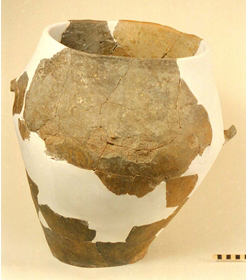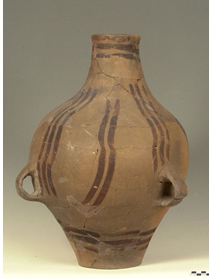Neolithic : Food and Culinary practices
Storage


Various facilities were used for the storage of solid (
grain, fruits, vegetables) or liquid foodstuffs, (
water, oil, or possibly wine). They varied according to the duration and nature of storage:
ceramic vessels ,
jars or bins from raw clay,
storage pits, uncoated or coated with an insulating material. The capacity of the largest ceramic vessels (jars with or without a neck, found in several houses of the Late Neolithic I and II) is approximately 35-40 litres, while that of raw clay jars (found in large number in the LN II
house 4) could reach more than 200 litres. The capacity of the bins cannot be calculated with precision since none were found intact. However, judging from the estimated dimensions of one of the bins discovered in the
courtyard of a LN I house (diameter of the cover c. 50 cm), they probably did not contain more than 50 litres of grain.

 Various facilities were used for the storage of solid (grain, fruits, vegetables) or liquid foodstuffs, (water, oil, or possibly wine). They varied according to the duration and nature of storage: ceramic vessels ,jars or bins from raw clay, storage pits, uncoated or coated with an insulating material. The capacity of the largest ceramic vessels (jars with or without a neck, found in several houses of the Late Neolithic I and II) is approximately 35-40 litres, while that of raw clay jars (found in large number in the LN II house 4) could reach more than 200 litres. The capacity of the bins cannot be calculated with precision since none were found intact. However, judging from the estimated dimensions of one of the bins discovered in the courtyard of a LN I house (diameter of the cover c. 50 cm), they probably did not contain more than 50 litres of grain.
Various facilities were used for the storage of solid (grain, fruits, vegetables) or liquid foodstuffs, (water, oil, or possibly wine). They varied according to the duration and nature of storage: ceramic vessels ,jars or bins from raw clay, storage pits, uncoated or coated with an insulating material. The capacity of the largest ceramic vessels (jars with or without a neck, found in several houses of the Late Neolithic I and II) is approximately 35-40 litres, while that of raw clay jars (found in large number in the LN II house 4) could reach more than 200 litres. The capacity of the bins cannot be calculated with precision since none were found intact. However, judging from the estimated dimensions of one of the bins discovered in the courtyard of a LN I house (diameter of the cover c. 50 cm), they probably did not contain more than 50 litres of grain.

